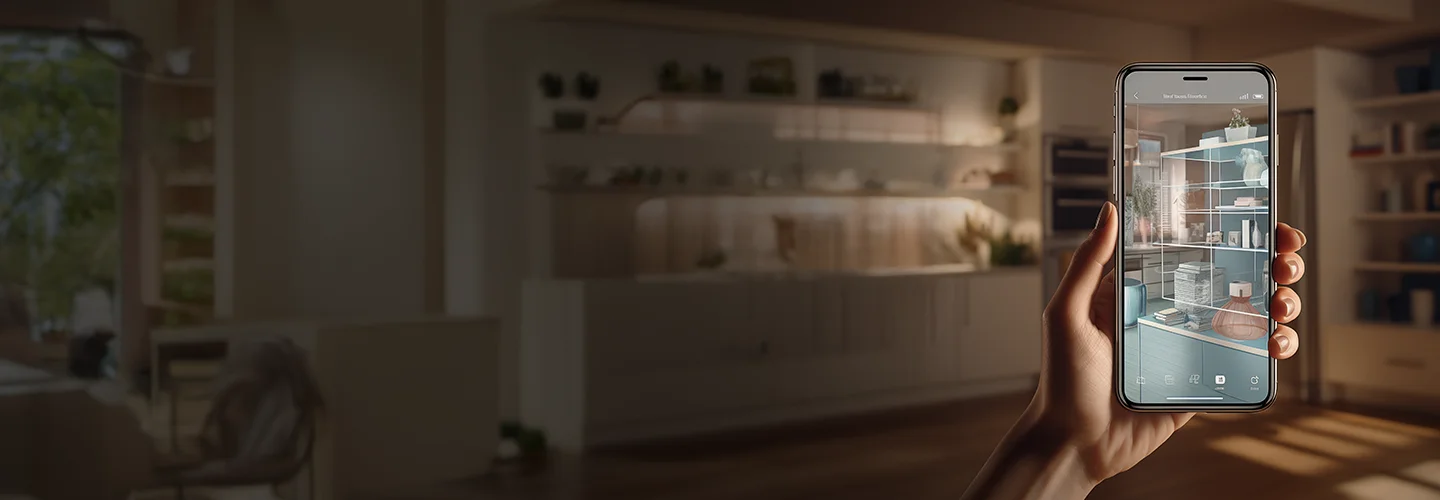Recommended Blogs

Your Customers See More Than Reality: Is Your Mobile Strategy Keeping Up?
Table of Content
- Why Extended Reality Matters Now?
- Core Components Behind XR in Mobile Apps
- UX Principles in Extended Reality Mobile Apps
- Real-World Use Cases of XR in Mobile Applications
- Securing Immersive Worlds: Privacy, Ethics, and Data in XR Environments
- How Does Tx Ensure Quality in Your XR-Driven Mobile Apps?
- Summary
The world where digital information overlaps with physical space, virtual objects and real-world elements blend, and people connect with others in shared experiences is already here. What was once a concept in Sci-fi movies is now a reality. And all of this is possible with Extended Reality (XR). Technologies like Virtual Reality (VR), Augmented Reality (AR), and Mixed Reality (MR) are integrating with mobile applications to transform digital and physical experiences.
According to statistics, the global extended reality market will reach $1.1 trillion by 2030, making it one of the core technologies for elevating brand reputation. Its impact goes beyond entertainment and gaming. Industries like retail, education, e-commerce, and healthcare are already using this technology to drive innovation, improve results, and reduce costs.
Why Extended Reality Matters Now?
Extended Reality, encompassing VR, AR, and MR, is increasingly being adopted across various sectors to create immersive and interactive user experiences. Its significance lies in five areas:
Work and Collaboration:
VR meetings and virtual offices have made remote working more immersive. Also, 3D designing, engineering workflows, and prototyping are now scalable in virtual environments. The XR training simulations across industries offer safe and cost-effective learning environments.
Networking:
Extended Reality is also changing how businesses network in virtual settings. Companies increasingly share access to virtual offices, showrooms, or property walkthroughs created through digital scans, allowing stakeholders to explore spaces remotely during meetings or events. These experiences are often shared using lightweight digital touchpoints, such as a digital business card, which can link virtual environments, contact details, and follow-up actions in one place. Uniqode’s business card is one example used in this context alongside meeting platforms and collaboration tools.
Healthcare Advancements:
XR applications in surgical planning, rehabilitation, pain management, etc., show the rapid innovations this industry is going through. Also, augmented tools assist surgeons during operations with real-time data overlays.
E-Learning:
Classrooms and corporate training use XR applications to provide experiential learning. It brings history, science, and vocational subjects to life through interactive 3D environments.
Retail and CX:
XR enables virtual try-ons for clothes, makeup, or furniture, enhancing the e-commerce experience. Myntra, Lenskart, Nykaa, and Shopify are some examples of e-commerce platforms that use XR technology. Brands use AR filters and VR showrooms for deeper engagement and personalization.
Entertainment and Gaming:
The gaming industry has become a massive revenue generator since the COVID pandemic. Companies leverage XR technologies to become more immersive, social, and spatial. Also, virtual concerts, museums, and sports experiences have broadened access and created new monetization models. Metaverse is a perfect example of this.
Core Components Behind XR in Mobile Apps
The core components of XR implementation in mobile apps involve a combination of hardware, software, and development frameworks. It brings an immersive experience to smartphones and tablets. Let’s take a broader look at its components in detail:
Hardware Components:
These are physical enablers that support XR usage in mobile devices. They include cameras, motion sensors (gyroscope, accelerometer, magnetometer), GPS and compass, LiDAR, and High-performance GPU/CPU. The primary purpose of this component is to set up the environment sensing and rendering base.
Software & Development Frameworks:
These components provide tools to build XR mobile apps. Some tools developers use to develop XR apps are ARKit (Apple), ARCore (Google), Unity, Unreal Engine, Vuforia, Wikitude, WebXR, and WebAR.
XR Features Enabled in Mobile Apps:
This component includes the hardware and software components that support the XR features in mobile apps. The capabilities involve surface detection, SLAM, image and object recognition, hand and face tracking, spatial audio, and cloud anchors. This component focuses on creating interaction and spatial awareness.
Network and Backend Infrastructure:
This component supports real-time experiences and data-driven extended reality. APIs for AI and ML, edge computing, 5G, and cloud services collectively support real-time sync and persistence.
UX Principles in Extended Reality Mobile Apps
| Principle Name | Why It Matters in XR Mobile UX | What Value Does It Deliver |
|---|---|---|
| Spatial Awareness | Ground digital content in the real world using real-world surfaces and dimensions. | Creates realistic, immersive experiences that feel natural. |
| Cognitive Load Management | Prevent users from getting overwhelmed by simplifying UI and reducing distractions. | Enhances focus, improves usability, and reduces user fatigue. |
| Intuitive Interaction | Use natural gestures, voice, or gaze for seamless control. | Lowers the learning curve and increases engagement. |
| Anchoring & Placement | Place virtual objects accurately within physical environments. | Improves precision, realism, and object permanence. |
| Accessibility | Adapt interfaces for diverse users and environments. | Expands usability to more people, including those with impairments. |
| Persistence & Continuity | Maintain object states and session context over time. | Supports long-term engagement and reusability. |
| Safety & Comfort | Prevent physical strain and reduce motion sickness. | Increases user confidence and promotes longer sessions. |
| Feedback & Affordances | Offer visual/audio cues that indicate interactivity or results. | Boosts trust, clarity, and satisfaction in interactions. |
| Mobile Optimization | Account for mobile hardware limits (battery, performance). | Ensures smooth, reliable experiences on a wide range of devices. |
Real-World Use Cases of XR in Mobile Applications
Virtual Try-On:
Extended Reality allows customers to visualize products in their environment before buying. Platforms like Myntra and IKEA Place use AR to overlay 3D models of clothing or furniture in the real world via a phone camera. This reduces the chances of returns and enhances customer engagement.
Healthcare:
AR and VR technologies provide immersive environments for medical training, remote surgeries, diagnostics, and telemedicine. Extended Reality guides clinicians in real-time procedures and simulates complex medical scenarios for training. This helps improve surgical precision, expand access to expert care, and reduce the cost and risk of hands-on medical training.
3D Visualization:
In real estate, enterprises use XR to visualize building plans, furniture layouts, or full-scale property walkthroughs on-site. Users can scan real-world space to anchor blueprints, 3D models, or interior designs. This reduces miscommunication and speeds up design validation.
Gaming:
The new generation of gaming uses XR technology to deliver an immersive experience to players. Games like Pokémon GO, Angry Birds AR, and Phasmophobia are great examples of next-gen gaming. It creates interactive gameplay by using location tracking, plane detection, and camera feeds. VR headsets are another option. They increase player engagement, encourage physical movement, and enhance social interaction.
Securing Immersive Worlds: Privacy, Ethics, and Data in XR Environments
Securing immersive XR environments requires addressing privacy, ethical, and data security concerns. Unlike traditional apps, XR systems capture highly sensitive information such as biometric data, spatial scans of physical environments, and behavioral patterns. This data infers emotions, habits, or even health conditions, raising risks of surveillance, manipulation, or data misuse. Real-time XR experiences depend on cloud infrastructure and multiple sensors, which expand the attack surface and demand robust safeguards like end-to-end encryption, on-device processing, and regular security audits.
From an ethical standpoint, XR design must prioritize transparency, informed consent, and inclusivity. Users should clearly understand what data is being collected and have control over its usage. Equally important is avoiding manipulative interfaces or experiences that influence decisions without users realizing it. To secure immersive worlds, enterprises must treat user data not only as a technical asset but as a matter of trust, ethics, and human dignity.
How Does Tx Ensure Quality in Your XR-Driven Mobile Apps?
At Tx, we assist in ensuring the quality and reliability of your XR-driven mobile apps. Here’s how we ensure your extended reality-enabled apps meet user expectations and perform consistently across environments:
Functional Testing:
We validate core XR features like gesture input, object placement, and tracking to operate correctly across devices and operating systems.
Usability & UX Testing:
We assess how intuitively users interact with your virtual content, ensuring clarity and accessibility in real-world environments.
Performance Testing:
We measure your app’s responsiveness, frame rate, thermal behavior, and battery usage to ensure smooth performance during extended XR sessions.
Environmental Testing:
We test your app’s behavior in various physical conditions (lighting, surfaces, and movement) to ensure reliable tracking and consistent user experience.
Security & Privacy Testing:
We examine how your app collects, stores, and transmits personal data, ensuring compliance with security standards and privacy regulations.
Regression & Automation Testing:
We confirm that new changes don’t break existing XR features and use automated tools to reliably simulate sensor and camera input.
Summary
Extended Reality reshapes how users interact with mobile applications by merging digital experiences with the physical world. From intuitive UX principles to rigorous testing and real-world use cases, XR demands a thoughtful approach to design, functionality, and data handling. As industries adopt XR for practical applications beyond entertainment, ensuring secure, accessible, high-quality experiences becomes essential. Through rigorous testing across functionality, usability, performance, and environmental conditions, Tx helps businesses deliver immersive experiences that are innovative, trusted, and accessible to users everywhere. To know how Tx can help, contact our experts now.
FAQs
Extended Reality (XR) is an umbrella term that includes Virtual Reality (VR), Augmented Reality (AR), and Mixed Reality (MR) technologies. In mobile applications, XR enhances real-world experiences by blending digital elements with physical surroundings, using smartphones or tablets as the delivery platform.
XR is transforming mobile experiences by making them more immersive, interactive, and intelligent. As smartphones become more powerful and 5G connectivity grows, XR enables real-time applications in gaming, shopping, healthcare, and education.
Several industries are actively integrating XR in mobile apps to drive innovation and improve customer engagement:
Retail & E-commerce (Virtual try-ons, AR product previews)
– Healthcare (AR surgical training, remote diagnostics)
– Education & Training (Immersive learning, skill simulations)
– Gaming & Entertainment (Location-based AR games, interactive storytelling)
– Real Estate & Architecture (Virtual walkthroughs, design visualization)
– Travel & Hospitality (AR tourism guides, hotel previews)
An XR mobile app typically includes the following components:
- XR SDK or Framework
- Camera and Sensors Access
- 3D Content Engine
- Real-Time Processing
- User Interface (UI)
- Cloud & AI Services
User experience in XR mobile apps is fundamentally different from traditional apps due to spatial interaction and real-world integration. Key differences include:
- 3D Navigation vs. 2D scrolling
- Gesture and Voice Input instead of just taps and swipes
- Contextual Interfaces that adapt to surroundings
- Immersive Feedback through AR visuals and spatial sound
- Reduced Screen Dependence, allowing interaction with the environment
XR empowers businesses to deliver interactive, personalized, and memorable experiences. Benefits include:
- Higher Engagement
- Faster Decisions
- Improved Retention
- Increased Accessibility
- Brand Differentiation
Discover more
Stay Updated
Subscribe for more info

